Calcite
| Calcite | |
|---|---|
 | |
| General | |
| Category | Carbonate minerals |
Formula .mw-parser-output .noboldfont-weight:normal (repeating unit) | CaCO3 |
| Strunz classification | 5.AB.05 |
| Crystal system | Trigonal |
| Crystal class | Hexagonal scalenohedral (3m) H-M symbol: (3 2/m) |
| Space group | R3c |
| Unit cell | a = 4.9896(2) Å, c = 17.0610(11) Å; Z = 6 |
| Identification | |
| Color | Colorless or white, also gray, yellow, green |
| Crystal habit | Crystalline, granular, stalactitic, concretionary, massive, rhombohedral |
| Twinning | Common by four twin laws |
| Cleavage | Perfect on 1011 three directions with angle of 74° 55'[1] |
| Fracture | Conchoidal |
| Tenacity | Brittle |
Mohs scale hardness | 3 (defining mineral) |
| Luster | Vitreous to pearly on cleavage surfaces |
| Streak | White |
| Diaphaneity | Transparent to translucent |
| Specific gravity | 2.71 |
| Optical properties | Uniaxial (−) |
| Refractive index | nω = 1.640–1.660 nε = 1.486 |
| Birefringence | δ = 0.154–0.174 |
| Solubility | Soluble in dilute acids |
| Other characteristics | May fluoresce red, blue, yellow, and other colors under either SW and LW UV; phosphorescent |
| References | [2][3][4] |

Crystal structure of calcite
Calcite is a carbonate mineral and the most stable polymorph of calcium carbonate (CaCO3). The Mohs scale of mineral hardness, based on scratch hardness comparison, defines value 3 as "calcite".
Other polymorphs of calcium carbonate are the minerals aragonite and vaterite. Aragonite will change to calcite over timescales of days or less at temperatures exceeding 300 °C,[5][6] and vaterite is even less stable.
Contents
1 Etymology
2 Unit cell and Miller indices
3 Properties
3.1 Form
3.2 Hardness
3.3 Optical
3.4 Chemical
4 Use and applications
5 Natural occurrence
6 Formation processes
7 In Earth history
8 Gallery
9 See also
10 References
11 Further reading
Etymology
Calcite is derived from the German Calcit, a term coined in the 19th century from the Latin word for lime, calx (genitive calcis) with the suffix -ite used to name minerals. It is thus etymologically related to chalk.[7]
When applied by archaeologists and stone trade professionals, the term alabaster is used not just as in geology and mineralogy, where it is reserved for a variety of gypsum; but also for a similar-looking, translucent variety of fine-grained banded deposit of calcite.[8]
Unit cell and Miller indices
In publications, two different sets of Miller indices are used to describe directions in calcite crystals - the hexagonal system with three indices h, k, l and the rhombohedral system with four indices h, k, l, i. To add to the complications, there are also two definitions of unit cell for calcite. One, an older "morphological" unit cell, was inferred by measuring angles between faces of crystals and looking for the smallest numbers that fit. Later, a "structural" unit cell was determined using X-ray crystallography. The morphological unit cell has approximate dimensions a = 10 Å and c = 8.5 Å, while for the structural unit cell they are a = 5 Å and c = 17 Å. For the same orientation, c must be multiplied by 4 to convert from morphological to structural units. As an example, the cleavage is given as "perfect on 1 0 1 1" in morphological coordinates and "perfect on 1 0 1 4" in structural units. (In hexagonal indices, these are 1 0 1 and 1 0 4.) Twinning, cleavage and crystal forms are always given in morphological units.[3][9]
Properties
Form
Over 800 forms of calcite crystals have been identified. Most common are scalenohedra, with faces in the hexagonal 2 1 1 directions (morphological unit cell) or 2 1 4 directions (structural unit cell); and rhombohedral, with faces in the 1 0 1 or 1 0 4 directions (the most common cleavage plane).[9] Habits include acute to obtuse rhombohedra, tabular forms, prisms, or various scalenohedra. Calcite exhibits several twinning types adding to the variety of observed forms. It may occur as fibrous, granular, lamellar, or compact. A fibrous, efflorescent form is known as lublinite.[10] Cleavage is usually in three directions parallel to the rhombohedron form. Its fracture is conchoidal, but difficult to obtain.
Scalenohedral faces are chiral and come in pairs with mirror-image symmetry; their growth can be influenced by interaction with chiral biomolecules such as L- and D-amino acids. Rhombohedral faces are achiral.[9]
Hardness
It has a defining Mohs hardness of 3, a specific gravity of 2.71, and its luster is vitreous in crystallized varieties. Color is white or none, though shades of gray, red, orange, yellow, green, blue, violet, brown, or even black can occur when the mineral is charged with impurities.
Optical
Calcite is transparent to opaque and may occasionally show phosphorescence or fluorescence. A transparent variety called Iceland spar is used for optical purposes. Acute scalenohedral crystals are sometimes referred to as "dogtooth spar" while the rhombohedral form is sometimes referred to as "nailhead spar".

Photograph of calcite displaying the characteristic birefringence optical behaviour.
Single calcite crystals display an optical property called birefringence (double refraction). This strong birefringence causes objects viewed through a clear piece of calcite to appear doubled. The birefringent effect (using calcite) was first described by the Danish scientist Rasmus Bartholin in 1669. At a wavelength of ~590 nm calcite has ordinary and extraordinary refractive indices of 1.658 and 1.486, respectively.[11] Between 190 and 1700 nm, the ordinary refractive index varies roughly between 1.9 and 1.5, while the extraordinary refractive index varies between 1.6 and 1.4.[12]
Chemical
Calcite, like most carbonates, will dissolve with most forms of acid. Calcite can be either dissolved by groundwater or precipitated by groundwater, depending on several factors including the water temperature, pH, and dissolved ion concentrations. Although calcite is fairly insoluble in cold water, acidity can cause dissolution of calcite and release of carbon dioxide gas. Ambient carbon dioxide, due to its acidity, has a slight solubilizing effect on calcite. Calcite exhibits an unusual characteristic called retrograde solubility in which it becomes less soluble in water as the temperature increases. When conditions are right for precipitation, calcite forms mineral coatings that cement the existing rock grains together or it can fill fractures. When conditions are right for dissolution, the removal of calcite can dramatically increase the porosity and permeability of the rock, and if it continues for a long period of time may result in the formation of caves. On a landscape scale, continued dissolution of calcium carbonate-rich rocks can lead to the expansion and eventual collapse of cave systems, resulting in various forms of karst topography.
Use and applications

One of several calcite or alabaster perfume jars from the tomb of Tutankhamun, d. 1323 BC
Ancient Egyptians carved many items out of calcite, relating it to their goddess Bast, whose name contributed to the term alabaster because of the close association. Many other cultures have used the material for similar carved objects and applications.
High-grade optical calcite was used in World War II for gun sights, specifically in bomb sights and anti-aircraft weaponry.[13] Also, experiments have been conducted to use calcite for a cloak of invisibility.[14]
Microbiologically precipitated calcite has a wide range of applications, such as soil remediation, soil stabilization and concrete repair.
Calcite, obtained from an 80 kg sample of Carrara marble,[15] is used as the IAEA-603 isotopic standard in mass spectrometry for the calibration of δ18O and δ13C.[16]
Natural occurrence
Calcite is a common constituent of sedimentary rocks, limestone in particular, much of which is formed from the shells of dead marine organisms. Approximately 10% of sedimentary rock is limestone. It is the primary mineral in metamorphic marble. It also occurs in deposits from hot springs as a vein mineral; in caverns as stalactites and stalagmites; and in volcanic or mantle-derived rocks such as carbonatites, kimberlites, or rarely in peridotites.
Calcite is often the primary constituent of the shells of marine organisms, e.g., plankton (such as coccoliths and planktic foraminifera), the hard parts of red algae, some sponges, brachiopods, echinoderms, some serpulids, most bryozoa, and parts of the shells of some bivalves (such as oysters and rudists). Calcite is found in spectacular form in the Snowy River Cave of New Mexico as mentioned above, where microorganisms are credited with natural formations. Trilobites, which became extinct a quarter billion years ago, had unique compound eyes that used clear calcite crystals to form the lenses.[17]
The largest documented single crystal of calcite originated from Iceland, measured 7×7×2 m and 6×6×3 m and weighed about 250 tons.[18]
Formation processes
Calcite formation can proceed by several pathways, from the classical terrace ledge kink model[19] to the crystallization of poorly ordered precursor phases (amorphous calcium carbonate, ACC) via an Ostwald ripening process, or via the agglomeration of nanocrystals.[20]
The crystallization of ACC can occur in two stages: first, the ACC nanoparticles rapidly dehydrate and crystallize to form individual particles of vaterite. Secondly, the vaterite transforms to calcite via a dissolution and reprecipitation mechanism with the reaction rate controlled by the surface area of calcite.[21] The second stage of the reaction is approximately 10 times slower. However, the crystallization of calcite has been observed to be dependent on the starting pH and presence of Mg in solution.[22] A neutral starting pH during mixing promotes the direct transformation of ACC into calcite. Conversely, when ACC forms in a solution that starts with a basic initial pH, the transformation to calcite occurs via metastable vaterite, which forms via a spherulitic growth mechanism.[23] In a second stage this vaterite transforms to calcite via a surface-controlled dissolution and recrystallization mechanism. Mg has a noteworthy effect on both the stability of ACC and its transformation to crystalline CaCO3, resulting in the formation of calcite directly from ACC, as this ion destabilizes the structure of vaterite.
Calcite may form in the subsurface in response to activity of microorganisms, such as during sulfate-dependent anaerobic oxidation of methane, where methane is oxidized and sulfate is reduced by a consortium of methane oxidizers and sulfate reducers, leading to precipitation of calcite and pyrite from the produced bicarbonate and sulfide. These processes can be traced by the specific carbon isotope composition of the calcites, which are extremely depleted in the 13C isotope, by as much as −125 per mil PDB (δ13C).[24]
In Earth history
Calcite seas existed in Earth history when the primary inorganic precipitate of calcium carbonate in marine waters was low-magnesium calcite (lmc), as opposed to the aragonite and high-magnesium calcite (hmc) precipitated today. Calcite seas alternated with aragonite seas over the Phanerozoic, being most prominent in the Ordovician and Jurassic. Lineages evolved to use whichever morph of calcium carbonate was favourable in the ocean at the time they became mineralised, and retained this mineralogy for the remainder of their evolutionary history.[25]Petrographic evidence for these calcite sea conditions consists of calcitic ooids, lmc cements, hardgrounds, and rapid early seafloor aragonite dissolution.[26] The evolution of marine organisms with calcium carbonate shells may have been affected by the calcite and aragonite sea cycle.[27]
Calcite is one of the minerals that has been shown to catalyze an important biological reaction, the formose reaction, and may have had a role in the origin of life.[9] Interaction of its chiral surfaces (see Form) with aspartic acid molecules results in a slight bias in chirality; this is one possible mechanism for the origin of homochirality in living cells.[28]
Gallery
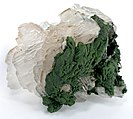
Calcite with mottramite
Trilobite eyes employed calcite

Calcite crystals inside a test of the cystoid Echinosphaerites aurantium (Middle Ordovician, northeastern Estonia)

Rhombohedrons of calcite that appear almost as books of petals, piled up 3-dimensionally on the matrix
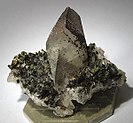
Calcite crystal canted at an angle, with little balls of hematite and crystals of chalcopyrite both on its surface and included just inside the surface of the crystal
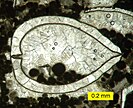
Thin section Calcite crystals inside a recrystallized bivalve shell in a biopelsparite

Several well formed milky white casts, made up of many small sharp calcite crystals, from the sulfur mines at Agrigento, Sicily
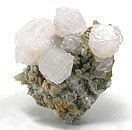
Manganoan calcite

Reddish rhombohedral calcite crystals from China. Its red color is due to the presence of iron

Calcite (var.: Cobaltoan calcite)
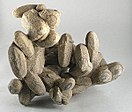
Sand calcites (calcites heavily included with desert sand) in South Dakota

Calcite from Ojuela Mine, Mapimí, Mapimí Municipality, Durango, Mexico

Calcite, butterfly twin, 4,0 × 3,3 × 1,6 cm. José María Patoni, San Juan del Río, Durango (México)
Calcite on Quartz, Rio Grande do Sul
See also
| Wikimedia Commons has media related to Calcite. |
Wikisource has the text of the 1911 Encyclopædia Britannica article Calcite. |
- Iceland Spar
- Ikaite, CaCO3·6H2O
- List of minerals
- Lysocline
- Manganoan Calcite, (Ca,Mn)CO3
- Monohydrocalcite, CaCO3·H2O
- Ocean acidification
Ulexite aka "TV rock", another mineral with an optical property often illustrated in the same way.- Yule Marble
References
^ Dana, James Dwight; Klein, Cornelis and Hurlbut, Cornelius Searle (1985) Manual of Mineralogy, Wiley, p. 329, .mw-parser-output cite.citationfont-style:inherit.mw-parser-output .citation qquotes:"""""""'""'".mw-parser-output .citation .cs1-lock-free abackground:url("//upload.wikimedia.org/wikipedia/commons/thumb/6/65/Lock-green.svg/9px-Lock-green.svg.png")no-repeat;background-position:right .1em center.mw-parser-output .citation .cs1-lock-limited a,.mw-parser-output .citation .cs1-lock-registration abackground:url("//upload.wikimedia.org/wikipedia/commons/thumb/d/d6/Lock-gray-alt-2.svg/9px-Lock-gray-alt-2.svg.png")no-repeat;background-position:right .1em center.mw-parser-output .citation .cs1-lock-subscription abackground:url("//upload.wikimedia.org/wikipedia/commons/thumb/a/aa/Lock-red-alt-2.svg/9px-Lock-red-alt-2.svg.png")no-repeat;background-position:right .1em center.mw-parser-output .cs1-subscription,.mw-parser-output .cs1-registrationcolor:#555.mw-parser-output .cs1-subscription span,.mw-parser-output .cs1-registration spanborder-bottom:1px dotted;cursor:help.mw-parser-output .cs1-ws-icon abackground:url("//upload.wikimedia.org/wikipedia/commons/thumb/4/4c/Wikisource-logo.svg/12px-Wikisource-logo.svg.png")no-repeat;background-position:right .1em center.mw-parser-output code.cs1-codecolor:inherit;background:inherit;border:inherit;padding:inherit.mw-parser-output .cs1-hidden-errordisplay:none;font-size:100%.mw-parser-output .cs1-visible-errorfont-size:100%.mw-parser-output .cs1-maintdisplay:none;color:#33aa33;margin-left:0.3em.mw-parser-output .cs1-subscription,.mw-parser-output .cs1-registration,.mw-parser-output .cs1-formatfont-size:95%.mw-parser-output .cs1-kern-left,.mw-parser-output .cs1-kern-wl-leftpadding-left:0.2em.mw-parser-output .cs1-kern-right,.mw-parser-output .cs1-kern-wl-rightpadding-right:0.2em
ISBN 0-471-80580-7.
^ Anthony, John W.; Bideaux, Richard A.; Bladh, Kenneth W.; Nichols, Monte C., eds. (2003). "Calcite" (PDF). Handbook of Mineralogy. V (Borates, Carbonates, Sulfates). Chantilly, VA, US: Mineralogical Society of America. ISBN 978-0962209741.
^ ab "Calcite". mindat.org. Retrieved 4 May 2018.
^ Barthelmy, Dave. "Calcite Mineral Data". webmineral.com. Retrieved 6 May 2018.
^ Yoshioka S.; Kitano Y. (1985). "Transformation of aragonite to calcite through heating". Geochemical Journal. 19 (4): 24–249. doi:10.2343/geochemj.19.245.
^ Staudigel P. T.; Swart P. K. (2016). "Isotopic behavior during the aragonite-calcite transition: Implications for sample preparation and proxy interpretation". Chemical Geology. 442: 130–138. doi:10.1016/j.chemgeo.2016.09.013.
^ "calcite (n.)". Online Etymology Dictionary. Retrieved 6 May 2018.
^ More about alabaster and travertine, brief guide explaining the different use of the same terms by geologists, archaeologists and the stone trade. Oxford University Museum of Natural History, 2012 [1]
^ abcd Hazen, Robert M. (2004). "Chiral crystal faces of common rock-forming minerals". In Palyi, C.; Zucchi, C.; Caglioti, L. Progress in Biological Chirality. Oxford: Elsevier. pp. 137–151.
^ "Lublinite". mindat.org. Retrieved 6 May 2018.
^ Elert, Glenn. "Refraction". The Physics Hypertextbook.
^ Thompson, D. W.; Devries, M. J.; Tiwald, T. E.; Woollam, J. A. (1998). "Determination of optical anisotropy in calcite from ultraviolet to mid-infrared by generalized ellipsometry". Thin Solid Films. 313–314 (1–2): 341–346. Bibcode:1998TSF...313..341T. doi:10.1016/S0040-6090(97)00843-2.
^ "Borrego's calcite mine trail holds desert wonders". Retrieved 2011-06-03.
^ Chen, Xianzhong; Luo, Yu; Zhang, Jingjing; Jiang, Kyle; Pendry, John B.; Zhang, Shuang (2011). "Macroscopic invisibility cloaking of visible light". Nature Communications. 2 (2): 176. arXiv:1012.2783. Bibcode:2011NatCo...2E.176C. doi:10.1038/ncomms1176. PMC 3105339. PMID 21285954.
^ Department of Nuclear Sciences and Applications, IAEA Environment Laboratories (16 July 2016). "Reference Sheet: Certified Reference Material : IAEA-603 (calcite) – Stable Isotope Reference Material for δ13C and δ18O" (PDF). IAEA. p. 2. Retrieved 28 February 2017.
^ "IAEA-603 , Calcite". Reference Products for Environment and Trade. International Atomic Energy Agency. Retrieved 27 February 2017.
^ Angier, Natalie (3 March 2014). "When Trilobites Ruled the World". The New York Times. Retrieved 10 March 2014.
^ Rickwood, P. C. (1981). "The largest crystals" (PDF). American Mineralogist. 66: 885–907.
^ De Yoreo, J. J.; Vekilov, P. G. (2003). "Principles of crystal nucleation and growth". Reviews in Mineralogy and Geochemistry. 54: 57–93. CiteSeerX 10.1.1.324.6362. doi:10.2113/0540057.
^ De Yoreo, J.; Gilbert, PUPA; Sommerdijk, N. A. J. M.; Penn, R. L.; Whitelam, S.; Joester, D.; Zhang, H.; Rimer, J. D.; Navrotsky, A.; Banfield, J. F.; Wallace, A. F.; Michel, F. M.; Meldrum, F. C.; Cölfen, H.; Dove, P. M. (2015). "Crystallization by particle attachment in synthetic, biogenic, and geologic environments". Science. 349 (6247): aaa6760. doi:10.1126/science.aaa6760. PMID 26228157.
^ Rodriguez-Blanco, J. D.; Shaw, S.; Benning, L. G. (2011). "The kinetics and mechanisms of amorphous calcium carbonate (ACC) crystallization to calcite, via vaterite". Nanoscale. 3 (1): 265–71. Bibcode:2011Nanos...3..265R. doi:10.1039/C0NR00589D. PMID 21069231.
^ Rodriguez-Blanco, J. D.; Shaw, S.; Bots, P.; Roncal-Herrero, T.; Benning, L. G. (2012). "The role of pH and Mg on the stability and crystallization of amorphous calcium carbonate". Journal of Alloys and Compounds. 536: S477–S479. doi:10.1016/j.jallcom.2011.11.057.
^ Bots, P.; Benning, L. G.; Rodriguez-Blanco, J. D.; Roncal-Herrero, T.; Shaw, S. (2012). "Mechanistic Insights into the Crystallization of Amorphous Calcium Carbonate (ACC)". Crystal Growth & Design. 12 (7): 3806–3814. doi:10.1021/cg300676b.
^ Drake, H.; Astrom, M. E.; Heim, C.; Broman, C.; Astrom, J.; Whitehouse, M.; Ivarsson, M.; Siljestrom, S.; Sjovall, P. (2015). "Extreme 13C depletion of carbonates formed during oxidation of biogenic methane in fractured granite". Nature Communications. 6: 7020. Bibcode:2015NatCo...6E7020D. doi:10.1038/ncomms8020. PMC 4432592. PMID 25948095.
^ Porter, S. M. (2007). "Seawater Chemistry and Early Carbonate Biomineralization". Science. 316 (5829): 1302. Bibcode:2007Sci...316.1302P. doi:10.1126/science.1137284. PMID 17540895.
^ Palmer, Timothy; Wilson, Mark (2004). "Calcite precipitation and dissolution of biogenic aragonite in shallow Ordovician calcite seas". Lethaia. 37 (4): 417–427. doi:10.1080/00241160410002135.
^ Harper, E.M.; Palmer, T.J.; Alphey, J.R. (1997). "Evolutionary response by bivalves to changing Phanerozoic sea-water chemistry". Geological Magazine. 134 (3): 403–407. Bibcode:1997GeoM..134..403H. doi:10.1017/S0016756897007061.
^ Meierhenrich, Uwe (2008). Amino acids and the asymmetry of life caught in the act of formation. Berlin: Springer. pp. 76–78. ISBN 9783540768869.
Further reading
- Schmittner, Karl-Erich; and Giresse, Pierre; 1999. "Micro-environmental controls on biomineralization: superficial processes of apatite and calcite precipitation in Quaternary soils", Roussillon, France. Sedimentology 46/3: 463–476.














